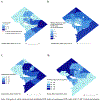Identifying Spatial Variation Along the HIV Care Continuum: The Role of Distance to Care on Retention and Viral Suppression
- PMID: 29603112
- PMCID: PMC6468992
- DOI: 10.1007/s10461-018-2103-8
Identifying Spatial Variation Along the HIV Care Continuum: The Role of Distance to Care on Retention and Viral Suppression
Abstract
Distance to HIV care may be associated with retention in care (RIC) and viral suppression (VS). RIC (≥ 2 HIV visits or labs ≥ 90 days apart in 12 months), prescribed antiretroviral therapy (ART), VS (< 200 copies/mL at last visit) and distance to care were estimated among 3623 DC Cohort participants receiving HIV care in 13 outpatient clinics in Washington, DC in 2015. Logistic regression models and geospatial statistics were computed. RIC was 73%; 97% were on ART, among whom 77% had VS. ZIP code-level clusters of low RIC and high VS were found in Northwest DC, and low VS in Southeast DC. Those traveling ≥ 5 miles had 30% lower RIC (adjusted odds ratio (aOR) 0.71, 95% CI 0.58, 0.86) and lower VS (OR 0.70, 95% CI 0.52, 0.94). Geospatial clustering of RIC and VS was observed, and distance may be a barrier to optimal HIV care outcomes.
Keywords: Care continuum; Distance; Retention; Spatial patterns; Viral suppression.
Figures


References
-
- Shacham E, Estlund AL, Tanner AE, et al. Challenges to HIV management among youth engaged in HIV care. AIDS Care. 2017. February;29(2):189–196. - PubMed
MeSH terms
Substances
Grants and funding
LinkOut - more resources
Full Text Sources
Other Literature Sources
Medical

